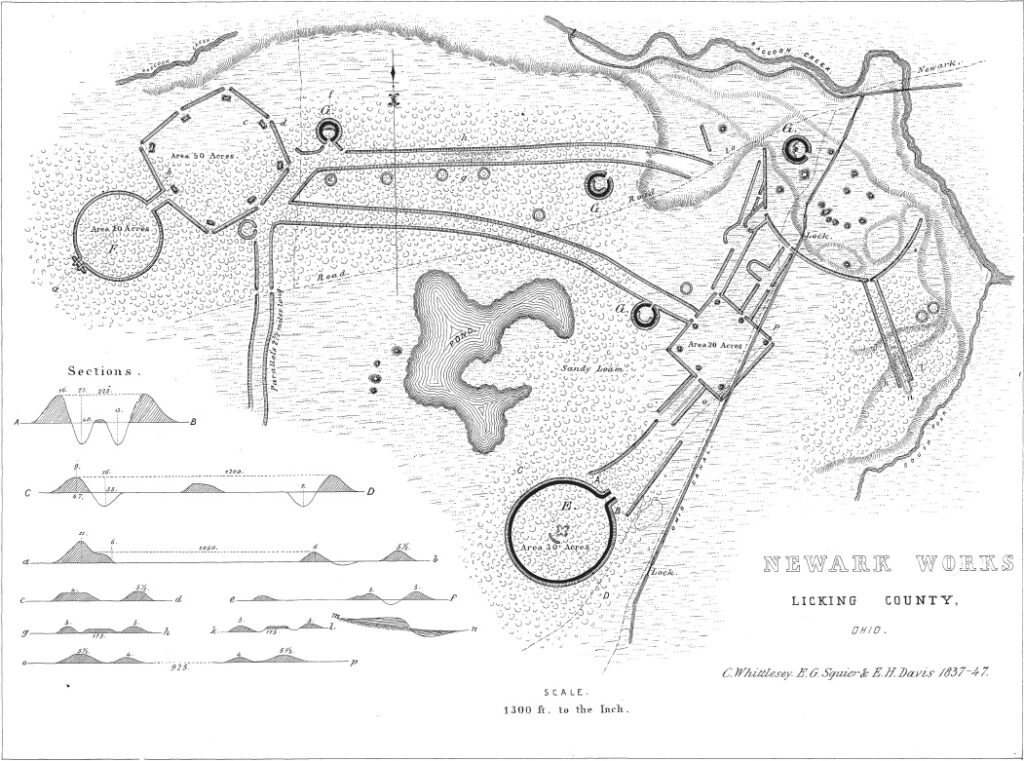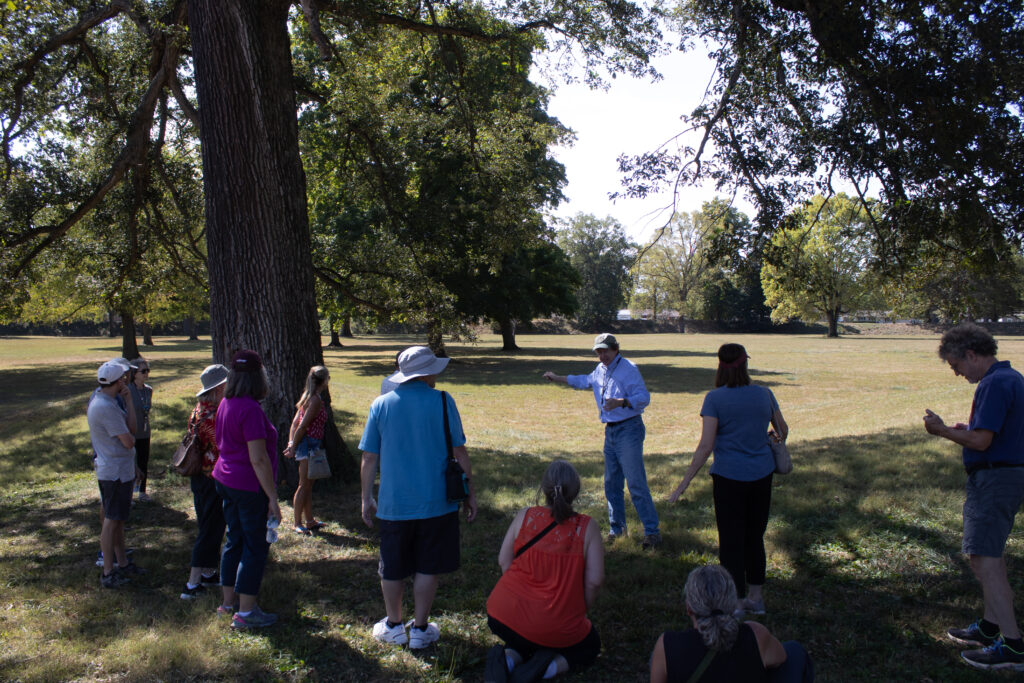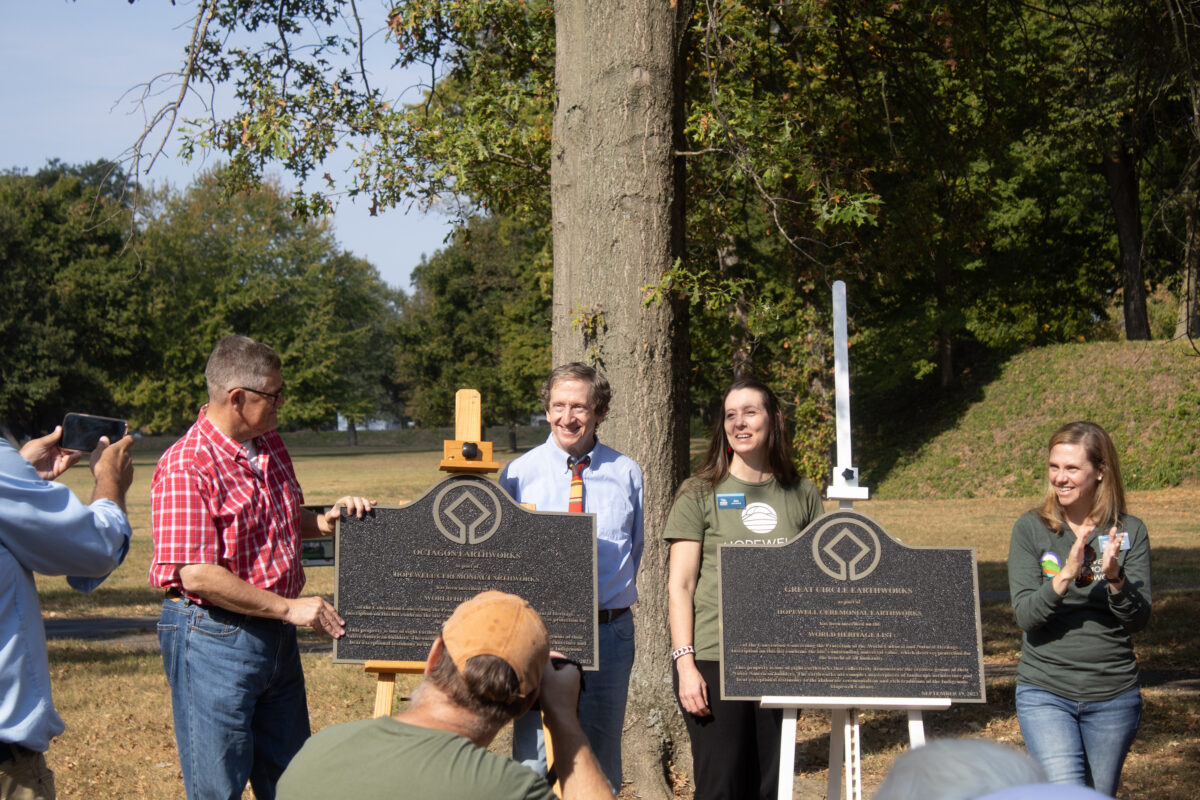Under the canopy of an oak tree on Eagle Mound at the Newark Earthworks, visitors listen to birdsong, the lull of passing vehicles and the musings of archaeologist Brad Lepper on the contended shape of the mound — a celestial-pointing arrow or a bird — which lent it its name.
But the trees planted across the site — -though magnificent — aren’t actually ancient. Before the Hopewell people built the earthworks, the land was deliberately transformed and maintained as a prairie. As the Hopewell people were removed from the land, so was the managed environment, thus inviting the growth of trees.
Studies on the soil, Lepper said, revealed this. The layers of the ground — like the reconstructed Eagle Mound — also show the marks of past visitors. From 1854 until the land was purchased by Ohio History Connection in 1933, the Great Circle was the site of the Licking County Fairgrounds. In 1878, a grand reunion of Civil War soldiers saw roughly 20,000 visitors, including U.S. President Hayes, the future President Garfield and General William Sherman.
In 1892, a striking majority of Licking County citizens voted to raise their own taxes in order to purchase and preserve the Octagon earthworks property. In 1933, the Civilian Conservation Corps took up the task of restoration, including the reconstruction of the Eagle Mound which had been trampled and diminished over the years.

Now, on the the earthworks’ one-year anniversary as a UNESCO World Heritage Site, Ohio History Connection’s effort is about more than restoration; it’s also about storytelling.
On Sept. 21, the Newark Earthworks celebrated one year on the UNESCO World Heritage site list.
The day began with unveiling a plaque and several brief speeches by Ohio History Connection (OHC) CEO Megan Wood and Newark Mayor Jeff Hall.
After guided tours at 11:45 a.m., volunteer tour guide Jeff Gill — a columnist for The Reporting Project — led the Remnants Walking Tour from 1-4 p.m., bringing visitors outside of the Great Circle and Octagon, and into town where more earthwork remnants lie in backyards, alleys and neighborhoods. Throughout the day, there was also atlatl spear-throwing and earthwork-building demonstrations.



“Sometimes you don’t know what you have in your backyard,” Hall said in his commemoration speech, minutes before the unveiling of the World Heritage plaque. Hall remarked on the profound significance of the site which he grew up around, but was never truly aware of in his youth. “Our greatest asset, it’s not the bricks and mortar, even the dirt; it’s the people.”
Read more: “There’s peace here” — The Newark Earthworks is designated a World Heritage Site
In his speech, Licking County Commissioner Tim Bubb echoed this sentiment. It’s more than just tourism, Bubb said, it’s also about education and awareness. Moving forward with marketing, the hope is to create a more interactive, personal experience which connects the eight earthworks sites as they once were.
“Let’s not get our expectations over the sky and the moon and the stars. You have a one year old child; the potential is there, but there’s a life to live,” Bubb said. “Just like any one-year-old, there’s a lot to do.”


Over the past year, the earthworks have seen four times more visitors than before the designation, according to Ohio History Connection CEO Megan Wood. This number is expected to significantly increase with the public opening of the Octagon Earthworks in January 2025.
With the addition of another site to caretake and greater funding opportunities since the designation, Ohio History Connection plans to continue long-term improvements on both the landscape and educational programs.
“It’s not going to be immediate, and I think that’s kind of a comfort in the community. It’s not like day one, bulldozers are going to come in and take down the building. It’s going to be an evolution,” Wood said.
“You are now inside the square,” Jeff Gill, volunteer tour guide and wandering storyteller, said as the Remnants Tour group entered a paved parking lot at the intersection of Grant and St Williams Street in residential Newark.
The path of the square winds through the surrounding neighborhood, but the only remaining evidence is the slight change in elevation, street names and the shuttered, conspicuously named “Mound School.”
Ending the official tour at the Wright Earthworks, Gill pointed out the remaining fragments: two converging walls at the northernmost corner of what would have been the square. The “Pluto” of the earthworks, Wright Square was originally the ninth site included in the UNESCO nomination. However, it was deemed to be less established and the proposal was simplified to the current eight earthworks.



“I hope someday this too will be a World Heritage Site,” Gill said. “It’s very small, but to me, this helps ground the truth.”
Once, the square and Cherry Valley Ellipse were connected by an extensive four-square-mile walkway. The mounds in the oval were virtually destroyed by a combination of the construction of the Erie Canal, the arrival of the Central Ohio Railroad Company and the expansion of the town.
Now looking across State Route 79, the perimeters of the Cherry Valley Ellipse stretch roughly from a BP gas station to the barely visible golden point of the Newark Courthouse in the horizon.
The landscape will never be fully returned to its original architecture 2,000 years ago. But like attempts to change the tourism at Stonehenge, there is work to be done that can both deepen understanding and pay homage to the dedicated people who built these mounds with one basket of “Mother Earth” at a time.
This story was updated at 11:40 a.m. on Tuesday, Sept. 24 to identify the road the tour group was walking across while visiting the Cherry Valley Ellipse.
Mia Fischel writes for TheReportingProject.org, the nonprofit news organization of Denison University’s Journalism program, which is supported by generous donations from readers. Sign up for The Reporting Project newsletter here.

